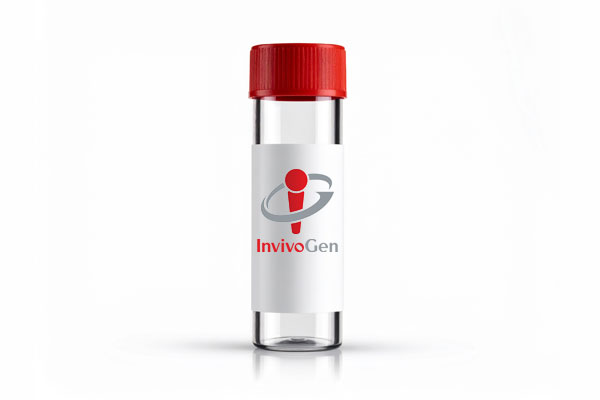THP1-Lucia™ NFAT Cells
-
Cat.code:
thpl-nfatNEW
- Documents
ABOUT
NFAT–Lucia reporter monocytes
THP1-Lucia™ NFAT cells were specifically designed for monitoring the NFAT signal transduction pathway in a physiologically relevant innate immune cell line. They provide a robust tool to study NFAT (Nuclear Factor of Activated T cells) activation in myeloid responses, particularly in the context of pathogen defense and inflammation.
THP1-Lucia™ NFAT cells were derived from the human THP-1 monocyte cell line by stable integration of an NFAT-inducible Lucia® reporter construct. As a result, these cells allow the monitoring of NFAT activation by assessing the activity of secreted Lucia® luciferase in the cell culture supernatant by using QUANTI-Luc™ 4 Lucia/Gaussia, a Lucia® detection reagent.
THP1-Lucia™ NFAT cells respond to cell-permeable small molecules, triggering calcium signaling and subsequently activating NFAT, such as with Ionomycin. However, they do not respond to mitogenic NFAT activators, including Phytohaemagglutinin P (PHA-P) or Concanavalin A (Con A) (see figure). This cell line can be used to screen for inhibitors of the NFAT pathway, as verified using FK506 (aka Tacrolimus), a strong calcineurin pathway inhibitor (see figure).
As THP-1 cells endogenously express many pattern-recognition receptors (PRRs), including Toll-like receptors (TLRs), the stimulator of interferon genes (STING), and RIG-I-like receptors (RLR), THP1-Lucia™ NFAT cells also respond to various PRR agonists that trigger the NFAT pathway (see figure).
Disclaimer: These cells are for internal research use only and are covered by a Limited Use License (See Terms and Conditions). Additional rights may be available.
SPECIFICATIONS
Specifications
NFAT activation cellular assays
Complete RPMI 1640 (see TDS)
Verified using Plasmotest™
Each lot is functionally tested and validated.
CONTENTS
Contents
-
Product:THP1-Lucia™ NFAT Cells
-
Cat code:thpl-nfat
-
Quantity:3-7 x 10^6 cells
- 1 ml of Zeocin® (100 mg/ml)
- 1 ml of Normocin® (50 mg/ml)
- 1 tube of QUANTI-Luc™ 4 Reagent (Lucia luciferase detection reagent)
Shipping & Storage
- Shipping method: Dry ice
- Liquid nitrogen vapor
- Upon receipt, store immediately in liquid nitrogen vapor. Do not store cell vials at -80°C.
Storage:
Caution:
Details
Cell line description
THP1-Lucia™ cells were derived from the human THP-1 monocyte cell line by stable integration of an NFAT-inducible Lucia® reporter construct. THP1-Lucia™ NFAT cells feature the Lucia luciferase gene, a secreted luciferase reporter gene, under the control of an ISG54 minimal promoter fused to six NFAT response elements.
As a result, THP1-Lucia™ NFAT cells allow the monitoring of NFAT activation by determining the activity of Lucia® luciferase. The levels of NFAT-induced Lucia® in the cell culture supernatant are readily assessed with QUANTI-Luc™ 4 Lucia/Gaussia, a Lucia® and Gaussia luciferase detection reagent. As THP-1 cells represent innate immune monocytes, they express a variety of pattern recognition receptors (PRRs). Thus, THP1-Lucia™ NFAT cells induce the activation of NFAT in response to PRR-ligands as well as cell-permeable small molecules (e.g., Ionomycin).
NFAT in Myeloid Cells
The nuclear factor of activated T cells (NFAT) comprises a family of transcription factors originally described as regulators of interleukin-2 (IL-2) expression in T cells [1]. In resting cells, NFATs are maintained in an inactive state in the cytosol. NFAT activation in innate immune cells, such as dendritic cells (DCs) and macrophages, can occur following ligation of several pattern recognition receptors (PRRs), including the TLR4–CD14 complex, TLR9, NOD-1, and dectin‐1 [2-3]. Subsequent increased intracellular calcium flux activates calmodulin, which in turn stimulates the phosphatase calcineurin. Activated calcineurin dephosphorylates NFAT, allowing its nuclear translocation, where it cooperates with transcription factors such as AP-1 to drive gene expression [4]. In innate immune cells, the key functions of NFAT are linked to phagocytosis, cytokine production (e.g. IL-2, IL-10, TNF-α), and antifungal defense [2].
Implications for Immunosuppression
Calcineurin/NFAT inhibitors, such as cyclosporine A (CsA) and tacrolimus (FK506), are primarily used to prevent allograft rejection and to treat GVHD after bone marrow transplantation. These drugs are also used to treat a wide variety of immune disorders that include atopic dermatitis and refractory colitis [2]. The immunosuppressive state induced by these drugs is mainly achieved by inhibition of T cell cytokine production and limits the release of IL-2 [2].
Despite their clinical value, the broad inhibition of NFAT signaling comes at a cost. Patients receiving calcineurin inhibitors show markedly increased susceptibility to bacterial and fungal infections [4]. Indeed, severe invasive fungal infections occur in ∼3% of post‐transplant patients per year, leading to death in almost 40% of affected patients [3]. This increase in susceptibility towards microbial infections has been considered for a long time to be largely non-specific [4]. However, accumulating evidence suggests that they are not solely a consequence of impaired T cell responses but also reflect compromised myeloid cell function [1-4].
Further research into NFAT signaling in myeloid cells will not only refine our understanding of innate immunity but also pave the way for safer, more tailored immunosuppressive regimens.
1. Fric J, et al., 2012. Calcineurin/NFAT signalling inhibits myeloid haematopoiesis. EMBO Mol Med. (4):269-82.
2. Fric J, et al., 2012. NFAT control of innate immunity. Blood. 120(7):1380-9.
3. Bendíčková K, et al., 2020. Calcineurin inhibitors reduce NFAT-dependent expression of antifungal pentraxin-3 by human monocytes. J Leukoc Biol. 107(3):497-508.
4. Vandewalle A, et al., 2014. Calcineurin/NFAT signaling and innate host defence: a role for NOD1-mediated phagocytic functions. Cell Commun Signal. 12:8.
DOCUMENTS
Documents
Technical Data Sheet
Safety Data Sheet
Validation Data Sheet
Certificate of analysis
Need a CoA ?






